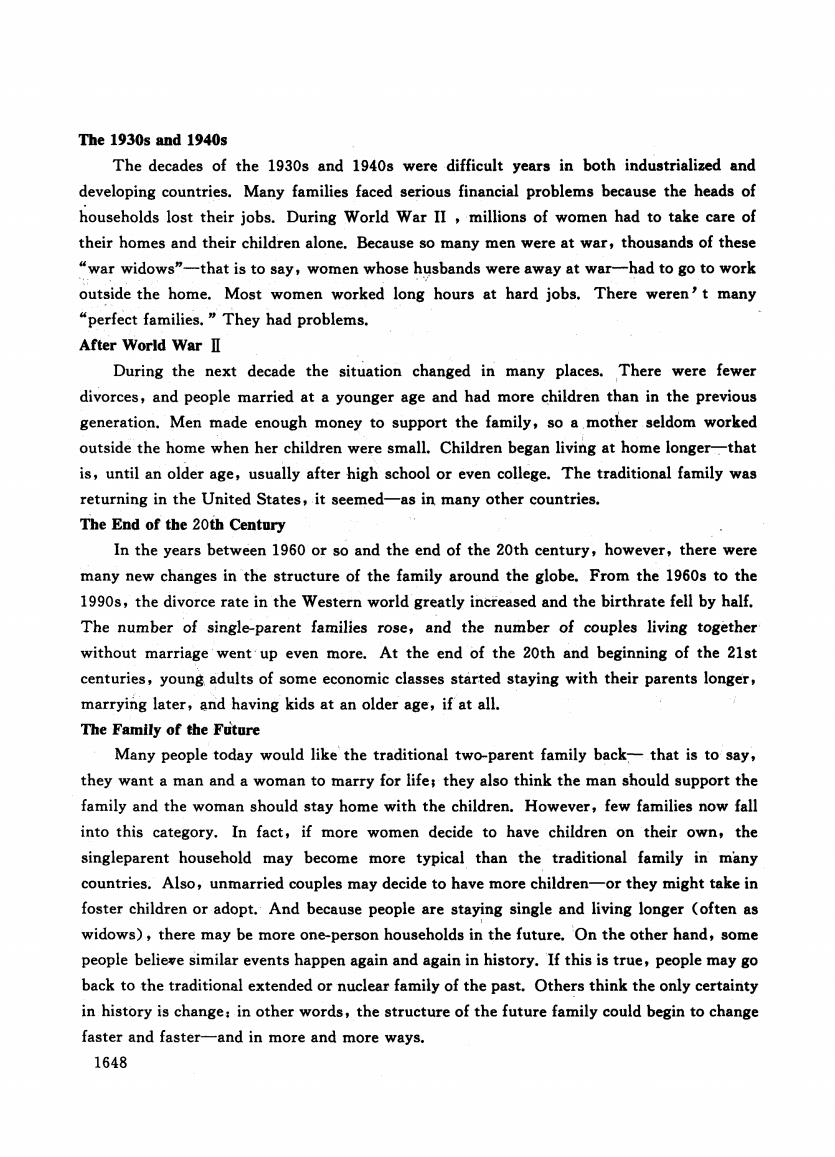正在加载图片...

The 1930s and 1940s The decades of the 1930s and 1940s were difficult years in both industrialized and developing countries.Many families faced serious financial problems because the heads of households lost their jobs.During World War II,millions of women had to take care of their homes and their children alone.Because so many men were at war,thousands of these "war widows"-that is to say,women whose husbands were away at war-had to go to work outside the home.Most women worked long hours at hard jobs.There weren't many “perfect families..”They had problems.. After World War II During the next decade the situation changed in many places.There were fewer divorces,and people married at a younger age and had more children than in the previous generation.Men made enough money to support the family,so a mother seldom worked outside the home when her children were small.Children began living at home longer-that is,until an older age,usually after high school or even college.The traditional family was returning in the United States,it seemed-as in many other countries. The End of the 20th Century In the years between 1960 or so and the end of the 20th century,however,there were many new changes in the structure of the family around the globe.From the 1960s to the 1990s,the divorce rate in the Western world greatly increased and the birthrate fell by half. The number of single-parent families rose,and the number of couples living together without marriage went up even more.At the end of the 20th and beginning of the 21st centuries,young adults of some economic classes started staying with their parents longer, marrying later,and having kids at an older age,if at all. The Family of the Future Many people today would like the traditional two-parent family back-that is to say, they want a man and a woman to marry for life;they also think the man should support the family and the woman should stay home with the children.However,few families now fall into this category.In fact,if more women decide to have children on their own,the singleparent household may become more typical than the traditional family in many countries.Also,unmarried couples may decide to have more children-or they might take in foster children or adopt.And because people are staying single and living longer (often as widows),there may be more one-person households in the future.On the other hand,some people believe similar events happen again and again in history.If this is true,people may go back to the traditional extended or nuclear family of the past.Others think the only certainty in history is change:in other words,the structure of the future family could begin to change faster and faster-and in more and more ways. 1648The 19305 and 19405 The decades of the 1930s and 1940s were difficult years in both industrialized and developing countries. Many families faced serious financial problems because the heads of households lost their jobs. During World War II , millions of women had to take care of their homes and their children alone. Because so many men were at war, thousands of these "war widows"一that is to say , women whose husbands were away at war-…-had to go to work 。u the home. Most women worked long hours at hard jobs. There weren' t many "perfect families. " They had problems. After World War II During the next decade the situation changed in many places. There were fewer divorces, and people married at a younger age and had more children than in the previous generation. Men made enough money to support the family , so a .mother seldom worked outside the home when her children were small. Children began living at home longer-:-that is, until an older age , usually after high school or even college. The traditional family was returning in the United States,it seemed-as in many other countries. The End of the 20th Century In the years between 1960 or so and the end of the 20th century, however, there were many new changes in the structure of the family around the globe. From the 1960s to the 1990s, the divorce rate in the Western worldgreatly increased and the birthrate fell by half. The number of single-parent families rose, and the number of couples living together without marriage went up even more. At the end of the 20th and beginning of the 21st centuries, young adults of some economic classes started staying with their parents longer, marryitl.g later, arid having kids at an older age , if at all. FanJily of 曲eFuture Many people today would like the traditional two-parent family back-:- that is to say , they want a man and a woman to marry for life; they also think the man should support the family and the woman should stay home with the children. However, few families now fall into this category. In fact , if more women decide to have children on their own, the singleparent household may become more typical than the traditional family in many countries. Also , unmarried couples may decide to have more children一or they might take in foster children or adopt. And because people are staying single and living longer (often as widows) , there may be more one-person households in the future.On the other hand , some people beli~e similar events happen